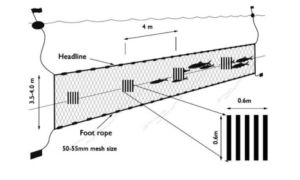High Visibility Net Panels
WHAT ARE HIGH VISIBILITY NET PANELS?
This modification involves increasing the visibility of nets to non-target wildlife species in order to alert them of the presence of gear and reduce the likelihood of wildlife-gear interactions. Seabirds have been found to be most receptive to visual alerts when underwater. It has been argued that – due to the low light and turbidity of coastal waters – visual alerts should be large net panels, with high internal monochrome contrast.
Gillnets can be made more visible to seabirds, for example, by the insertion of an opaque mesh netting into the upper portion of the gillnet. Changing the colour of nets may also increase their visibility to other wildlife species – see coloured rope & net.

Source: Field et al. 2019
CURRENT RESEARCH & USE
An early study suggested that thick white mesh panels were successful in reducing bycatch of auks in drifting gillnets in Puget Sound, although reduction in bycatch differed depending on the species of seabird, and the white panels also resulted in a significant reduction in target salmon catch.
A 2019 study in gillnet fisheries in the Baltic Sea trialed the use of high contrast monochrome (black and white) net panels attached to gillnets as a bycatch mitigation measure. Neither of the two most commonly bycaught species of seabird in the fishery (Long-tailed Ducks and Velvet Scoters) were deterred by the modified nets, when comparing responses to the standard nets. However, a trial in the West Greenland lumpfish fishery in 2021 found that the addition of net panels to the gillnets resulted in a 71% reduction in the rate of bycatch of Common Eider. While it also led to a 25% reduction in the rate of target catch, the study’s authors calculated that with an increase in fishing effort to make up for this, a bycatch reduction of 61% could still be achieved.
The varying success of this mitigation measure suggests that further research is needed, and that effectiveness is likely to be environmentally- and species-specific. Importantly, nets must be made visible to species of wildlife, but not to target catch.
This page was last updated on 12.10.23.
Interested in how this and other measures could mitigate bycatch in your fishery? Get in touch with us to collaborate or take part in a study.
